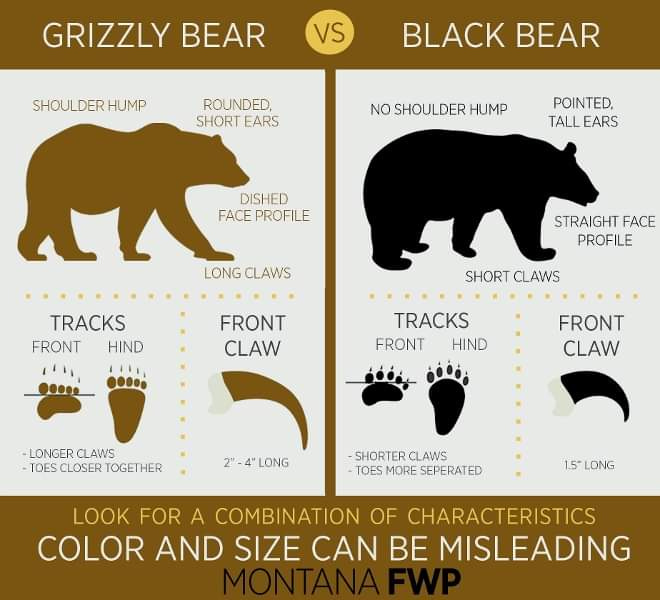A Bear Of A Different Color
Knowing the difference between a black bear and a brown bear can save your life. "Cinnamon bears" blur the lines, though.
Let’s begin with an old joke. Maybe you’ve heard it.
A park ranger is explaining to a group of tourists that when you’re hiking in the backcountry, wearing bells on your clothing alerts bears to your presence and helps avoid confrontations. Likewise, carrying a can of pepper spray can help ward off a bear, if one were to still attack.
The ranger also explains that learning to tell the difference between the poop of a black bear and the poop of brown bear (aka grizzly bear) can also be beneficial to hikers. Black bear poop tends to have lots of berries of in it, for instance.
But what about the grizzly poop, the tourists ask.
“Oh,” says the ranger, “you’ll know brown bear poop because it smells like pepper and has lots of little bells in it.”
…
Look, I didn’t say it was a good joke! Here’s a better one, if you’re a fan of The Office.
Anyway, the fact that this joke exists at all tells you how interested people are in learning the difference between black bears (Ursus americanus) and brown bears (Ursos arctos).
And actually, this apocryphal tale holds a grain of truth. Knowing the difference between these animals might just save your life.
The thing is, you can’t just look at a bear’s color to determine what species it is. One of the scientists I follow on Twitter (Danielle Rivet, @grizzlygirl87) runs a hashtag game called #KnockKnockWhosBear in which she posts tricky pictures of bears and asks people to guess at what they are. That’s because black bears can be brown, brown bears can have dark, black-ish fur, black bears can sometimes just get really huge, and young brown bears can take on the shapes more usually thought of as belonging to black bears.
Long story short, this stuff can be confusing, even for scientists! But here’s a basic guide—just note what it says at the bottom.
I Wanna Live With A Cinnamon Bear
Okay, not really. But I couldn’t pass up the the Neil Young reference.
Cinnamon bears are a real thing, though. It’s the nickname given to black bears with fur more like that of a brown bear. The color morph is most common in the American Southwest, but not unheard of all across the black bear’s range.
Now, there’s been a lot of speculation about cinnamon bears over the years. Probably because we humans like to draw neat little lines around things for our own convenience, so when the thing we so imaginatively named as the BLACK BEAR is sometimes BROWN, well, our little brains start to itch. Some folks have even proposed that cinnamon bears might actually be mimicking brown bears for their own protection, but that’s just speculation.
What scientist have done, though, is pinpoint the genetic basis for cinnamon coloration in black bears.

According to Emily Puckett, an evolutionary biologist at the University of Memphis, cinnamon coloration occurs thanks to just a single base pair out of around 2.3 billion base pairs that makeup the black bear’s DNA. (Puckett published a study on cinnamon bear genetics in the journal Current Biology last December.)
What’s more, a bear only needs one copy of that allele to come out cinnamon, says Puckett. Which means the color morph can keep spreading even if cinnamon bears don’t mate with each other.
The other cool thing? Puckett and her team estimate that cinnamon coloration arose in the Southwest around 9,000 years ago. So the fact that cinnamon bears can now be found in places like Pennsylvania and British Columbia hints at how genes flow through a population over time. The scientists also believe that the coloration provided some sort of selective advantage for the bears that had it, so being a cinnamon bear is actually a good thing. (Though exactly what that advantage is, again, we can only guess.)
Who Cares About Cinnamon Bears?
While peering into the individual building blocks of bear DNA is above most of our pay-grades, educating the public about these sorts of things has real-life benefits.
“I hope that all nature lovers, especially in the west, will care about brown black bears,” says Puckett. “I say ‘the west’ because when black bears and brown bears (the species) live together, a person encountering an indvidual should respond differently to each species.”
In general, the best way to approach any bear interaction is to first back away quietly, says Puckett. But if the bear engages you, the strategies diverge.
For black bears, you want to make yourself appear as large and imposing as possible. Shout, stomp, clap your hands and say yeah—whatever you have to do to scare the bear off. If a black bear attacks you, it sees you as dinner, and you need to disavow it of that notion. Most importantly, never play dead. Or you might wind up dead.
Brown bears require a more nuanced approach, though. In general, you want to make yourself as non-threatening as possible. And if things progress to the point of an attack, as absolutely impossible as it sounds, you actually do want to play dead.
I want to stress that THERE IS A LOT MORE TO ALL OF THIS, so if you’re curious or it’s relevant to your survival—like, you live in an area where both black and brown bears live, too—then please look to more in-depth sources than this email about cinnamon bear genetics. Sound good?
I’ll let Neil play us out.



